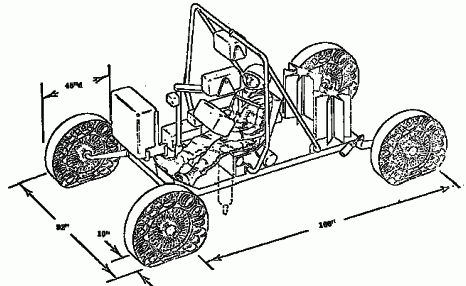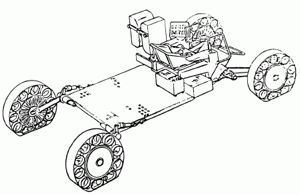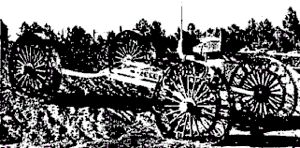
Home - Search - Browse - Alphabetic Index: 0- 1- 2- 3- 4- 5- 6- 7- 8- 9
A- B- C- D- E- F- G- H- I- J- K- L- M- N- O- P- Q- R- S- T- U- V- W- X- Y- Z
LSSM

LSSM
AKA: Local Scientific Survey Module. Status: Study 1968. Payload: 320 kg (700 lb). Gross mass: 900 kg (1,980 lb).
The typical, one-man configuration weighed in the order of 450 kg, was battery powered and had a total range capability of 200 km per mission. The crew sat in an open cockpit.
As envisioned in 1968, the single-person battery-powered go-cart would have four individually driven wheels, and be capable of a 14 day mission after 90 days of storage on the surface of the moon (it was expected to be delivered by an unmanned cargo carrier before the manned mission arrived). It had a nominal operating speed of 8 km/hour, an individual sortie duration of three to six hours, an 8 km radius of operation, with a total range of 25 km per sortie or 200 km per mission. The 900 kg operational mass consisted of 450 kg for the basic vehicle, 320 kg of cargo, and 130 kg for one astronaut and his space suit. Bendix built a prototype, but the far lighter and somewhat less capable two-crew Lunar Rover was developed instead.
Crew Size: 1. Crew: 130 kg (280 lb).
Family: Lunar Rovers, Moon. Country: USA. Spacecraft: AES Lunar Base. Agency: NASA, Bendix. Bibliography: 1991.
 | LSSM North American LSSM design. |
 | Bendix LSSM Credit: via Jean-Christophe Carbonel |
Back to top of page
Home - Search - Browse - Alphabetic Index: 0- 1- 2- 3- 4- 5- 6- 7- 8- 9
A- B- C- D- E- F- G- H- I- J- K- L- M- N- O- P- Q- R- S- T- U- V- W- X- Y- Z
© 1997-2019 Mark Wade - Contact
© / Conditions for Use